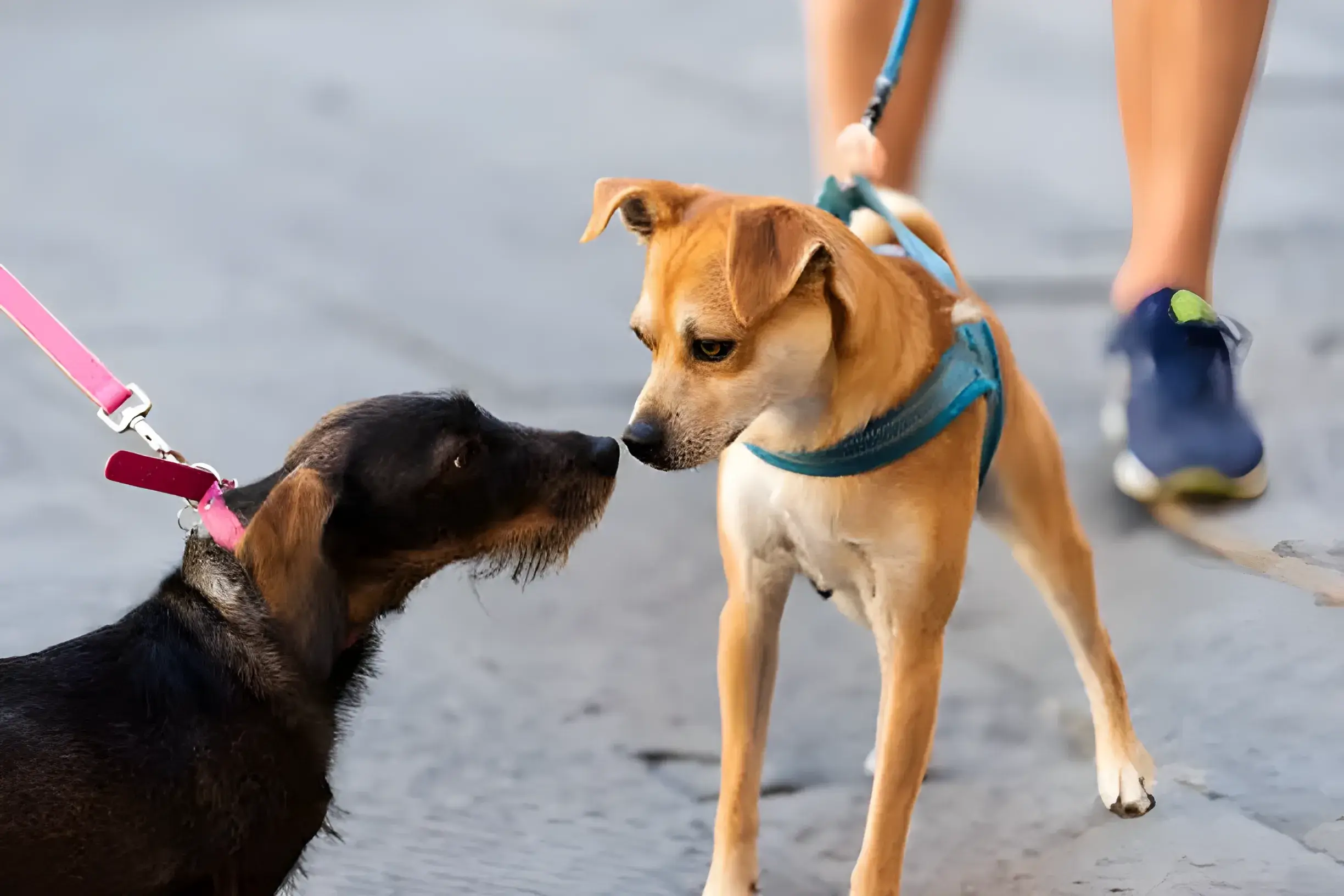Dogs are masters of communication, using a complex language of body signals, vocalizations, and even scent to express themselves to other dogs and humans. While they may not speak our language, they have a rich vocabulary of their own.
Decoding Dog Language: The Common Key Elements
1. Body Language: The Whole Picture
Dogs speak volumes through their posture, tail, ears, and facial expressions. Here are some key things to look for:
- Playful: Play bows (front end down, rear up), relaxed body, loose wagging tail.
- Submissive: Crouching low, tail tucked, ears back, avoiding eye contact.
- Alert: Ears perked up, tail held high, body tense.
- Aggressive: Stiff posture, raised hackles, snarling, direct eye contact.
2. Vocalizations: More Than Just Barks
Dogs communicate through a diverse range of sounds, including:
- Barks: These can express excitement (high-pitched), alertness (short, sharp), or defensiveness (deep, sustained).
- Growls: Growls vary in intensity, from playful rumbles to low, threatening warnings.
- Whines: Often signaling submission, a desire for attention, or discomfort.
- Howls: Used for long-distance communication, marking territory, or conveying loneliness.
3. The Power of Scent:
Invisible Messages Dogs have an incredible sense of smell and rely heavily on pheromones (chemical signals) to communicate:
- Urine Marking: Leaving their scent on objects conveys information about gender, availability, and social status.
- Sniffing: Intense sniffing of other dogs provides a wealth of information about identity and emotional state.
Decoding Dog Signals: Understanding the Different Modes
| Mode of Communication | Examples | What it Might Mean |
|---|---|---|
| Body Language | Play bow, tail wagging, ears perked, lowered head, growling | Playfulness, excitement, alertness, submission, aggression |
| Vocalizations | Barks (various pitches), growls, whines, howls | Alertness, playfulness, fear, anxiety, loneliness |
| Scent | Urine marking, sniffing, rolling in smelly things | Asserting territory, gathering information, seeking attention |
| Tactile | Nudging, pawing, leaning | Seeking attention, affection, anxiety, playfulness, comfort |
| Eye Contact | Direct stare, avoiding eye contact, soft blinking eyes | Dominance, submission, fear, trust, affection |
Understanding Context: The Key to Accurate Interpretation
It’s vital to consider a dog’s entire body language and the situation, not just single cues. A wagging tail can indicate happiness, but it can also signal excitement, nervousness, or uncertainty.
Understanding Your Dog’s Language
Paying attention to your dog’s communication style helps strengthen your bond. Here’s how to be a better listener:
Observe: Watch your dog in different situations and learn their individual cues.
Respond Appropriately: Respect signals of discomfort or fear and give them space. Reward positive social interactions.
Stay Positive: Avoid harsh punishments, as these can confuse and damage your relationship.
Common Misinterpretations of Dog Body Language
Many dog owners misinterpret their canine companions’ signals. Here’s how to avoid some common misunderstandings:

The Wagging Tail: Not Always a Happy Sign A fast, high wag often means excitement, but a slow, low wag can indicate uncertainty or wariness.
Belly Up: It’s Not Always About Belly Rubs Sometimes this is a submissive gesture meant to appease, not solicit petting. Look for other clues (flattened ears, tucked tail) to be sure.
Yawns Aren’t Just Sleepy Signals Yawning in dogs can indicate stress, especially in new situations. They might also yawn to de-escalate tension with another dog.
Building a Stronger Bond: How to Communicate with Your Dog
Learning to understand your dog’s unique language deepens your connection. Here’s how to become fluent:
Master the Language of the Body: Study common canine postures, tail positions, and facial expressions. Use online guides, books, or work with a dog trainer for in-depth knowledge.
Positive Reinforcement is Powerful: This training method encourages desired behaviors. Teach essential commands like “sit,” “stay,” and “come,” and reward your dog with treats, enthusiastic praise, and lots of affection.
Recognize Signs of Stress or Anxiety: Look for behaviors like excessive licking, pacing, panting, or trying to hide. If these occur often, consult your veterinarian or a professional animal behaviorist to find the root cause and develop solutions.
When to Seek Professional Help
While most dog behavior issues can be addressed through positive reinforcement training and owner education, there are times when seeking professional help from a qualified dog trainer or behaviorist is recommended:
Severe Aggression or Fear Issues: If your dog exhibits aggression towards people or other animals, or shows intense fearfulness in certain situations, professional guidance is crucial to ensure safety and address the underlying causes.
Difficulty Socializing with Other Dogs: Some dogs struggle with socialization and may need help learning how to interact with other dogs appropriately in a controlled environment.
Unexplained Changes in Behavior: Sudden and significant changes in your dog’s behavior could indicate an underlying medical problem or emotional distress. A veterinarian or behaviorist can help you rule out health concerns and address behavioral causes.
Conclusion
Understanding canine communication strengthens our bond with our furry companions. By learning to interpret their signals, we become better pet parents, avoid misunderstandings, and ensure a joyful, harmonious relationship.
The photo featured below the post headline is Credit: krblokhin/istockphoto
I hope you find this post helpful and informative. If Yes’ feel free to share it with your friends!
Frequently Asked Question
Why do dogs have a fascination with sniffing each other’s behinds?
Dogs have scent glands near their rears that release a wealth of personal information. Sniffing is their version of reading a detailed social media profile!
Does a wagging tail always mean the dog is happy?
Not necessarily! A high, fast wag can indicate excitement, but a slow, low wag can indicate uncertainty or wariness. Pay attention to the entire body for the full picture.
How can I help my shy dog socialize?
Start with brief, positive interactions with calm dogs in controlled environments. Supervise closely and reward your dog for any signs of positive engagement.
Why does my dog roll over and show its belly?
Rolling over can have several meanings. Sometimes it signals playfulness, but it can also be a submissive gesture or a sign of fear. Pay attention to other cues like flattened ears and tense body.
My dog growls when I play with them. Is this aggression?
Not always! Play growls are often a normal part of dog play and differ from aggressive growls in pitch and intensity. Watch your dog’s overall body language for cues.
How do dogs communicate with puppies differently than with adult dogs?
Adult dogs often use exaggerated signals and adjust their play style to help puppies learn boundaries and social skills.
Can different dog breeds have trouble understanding each other?
To some extent! Dog breeds with very different body shapes or signals (like a curled tail vs. a docked tail) might misinterpret each other initially, but they usually adapt quickly.
Why does my dog bark at certain people or other dogs?
There are many reasons: fear, territorial behavior, excitement, or alerting you to something. Understanding the context of the barking helps determine the cause.
How can I tell if two dogs are playing or fighting?
Playful interactions involve taking turns, relaxed body language, and bouncy movements. A real fight will appear stiff, one-sided, and may involve snarling or snapping.
How do I teach my dog to stop jumping on people?
Consistency is key! Ignore the jumping entirely (turn away, avoid eye contact) and reward your dog heavily when they have all four paws on the ground.
Does my dog understand when I’m angry at them?
They likely understand that you’re displeased, but might not connect their specific action with your reaction. Positive reinforcement is more effective for long-term training.

